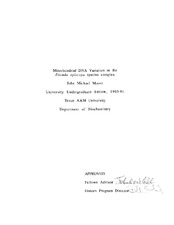Mitochondrial DNA Variation in the Dionda episcopa species complex
| dc.contributor.advisor | Gold, John Rush | |
| dc.creator | Moore, John Michael | |
| dc.date.accessioned | 2022-04-04T13:40:25Z | |
| dc.date.available | 2022-04-04T13:40:25Z | |
| dc.date.issued | 1991 | |
| dc.identifier.uri | https://hdl.handle.net/1969.1/CAPSTONE-DurkinM_1990 | |
| dc.description | Program year: 1990/1991 | en |
| dc.description | Digitized from print original stored in HDR | en |
| dc.description.abstract | The purpose of this study was to test the phylogenetic hypothesis proposed by Mayden et al. (1991) using restriction fragments of mitochondrial DNA (mtDNA). MtDNA provides another method by which a phylogenetic hypothesis can be inferred. The advantages of using mtDNA in phylogenetic analysis are severalfold. The molecule is small, physically circular, and transmitted maternally (Brown, 1983). In addition, the mutation rate in animal mtDNA is estimated to be from 5 to 10 times faster that that of single copy nuclear DNA (Brown, 1985). Because of the above, mtDNA has proven extremely useful in phylogenetic analysis, especially when dealing with closely related species (Bermingham and A vise, 1986; Moritz et aI., 1987; Avise et aI., 1987; Dowling and Brown, 1989). | en |
| dc.format.extent | 18 pages | en |
| dc.format.medium | electronic | en |
| dc.format.mimetype | application/pdf | |
| dc.subject | mitochondrial DNA | en |
| dc.subject | phylogenetic analysis | en |
| dc.subject | mutation rate | en |
| dc.subject | genus Dionda | en |
| dc.subject | allozyme variation | en |
| dc.title | Mitochondrial DNA Variation in the Dionda episcopa species complex | en |
| dc.type | Thesis | en |
| thesis.degree.department | Biochemistry | en |
| thesis.degree.grantor | University Undergraduate Fellow | en |
| thesis.degree.level | Undergraduate | en |
| dc.type.material | text | en |


